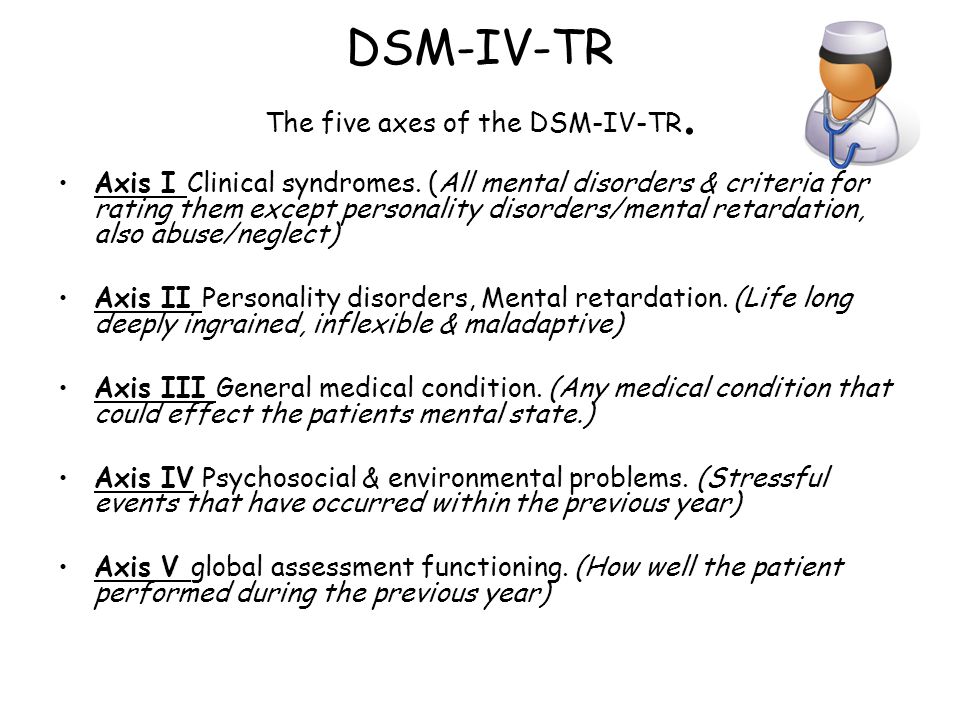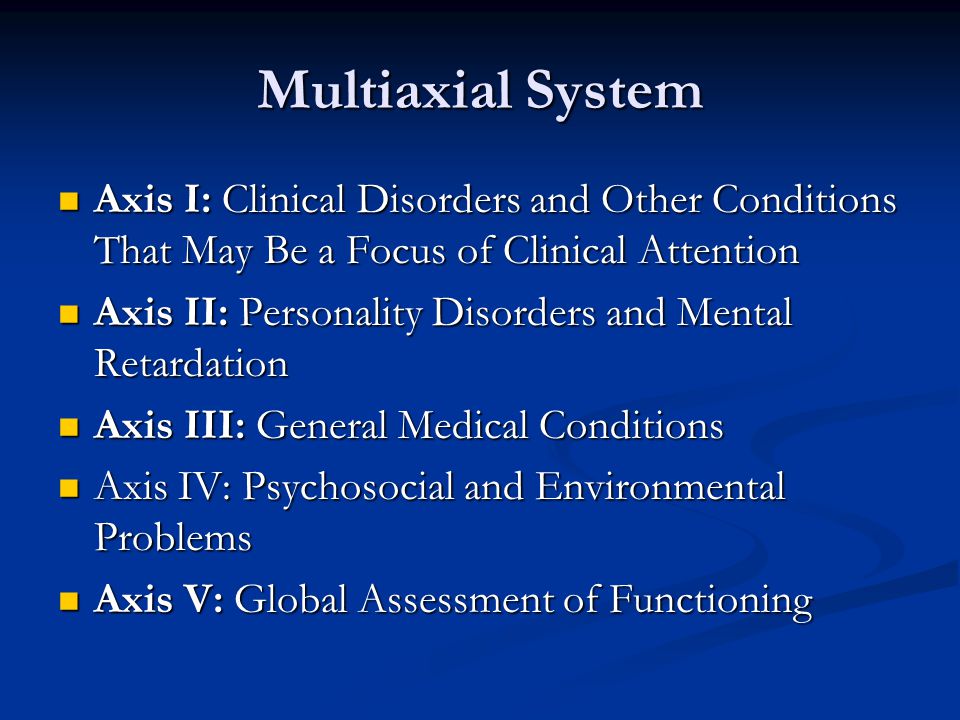The Dsm-iv-tr Uses Five Axes What Does Axis Ii Describe
And Axis V was an. Alzhemiers Disease _____ is are a progressive degenerative type of dementia featuring.

Classification Of Mental Disorders Ppt Download
For example a clinical disorder such as major depressive disorder would be assigned.

. Psychosocial and environmental problems. Psychosocial and environmental problems. Axis II was reserved for personality disorders and mental retardation.
Axis II contained pervasive psychological issues such as personality disorders personality traits and mental retardation now intellectual disability disorder that shaped responses to Axis I. 0-3R DSM-IV AXIS I. What is an axis III diagnosis.
What are DSM IV disorders. The DSM-IV-TR uses five axes. In addition the current fourth axis describing contributing stressors is now represented through.
Basic goals of psychiatric rehabilitation include recovery community integration and _____. -encompasses problematic ways of relating to world such as. General medical conditions Axis IV.
The first three relate to clinical diagnoses. It should also be noted that Section I of DSM-5 con-. Personality disorders Mental retardation AXIS III.
Though recent editions of the DSM and ICD have become more similar due to collaborative agreements each one contains information absent from the other. Axis IV was to note psychosocial and environmental problems eg housing employment. The multiaxial system was thought to give more detail.
In the DSM-IV-TR and in the upcoming DSM-V ADHD is coded on Axis I. The DSM-IV categorizes disorders according to the following five axes. Histrionic personality disorder paranoid personality disorder antisocial personality disorder.
Disorders that may be present on Axis I include. This axis includes notations about problematic aspects of the patients personality that fall short of the criteria for a personality disorder. Axis I disorder subgroups included affective disorder major depressive disorder dysthymia and bipolar disorder anxiety disorder overanxious separation anxiety and social phobia disruptive disorder attention deficit disorder oppositiondefiant disorder and conduct disorder and substance use disorder.
What does Axis II describe. Clinical disorders AXIS II. Clinical disorders and other clinical conditions that may be the focus of clinical attention Axis II.
Axis IV was to note psychosocial and environmental problems eg housing employment. Major Depressive Disorder Single Episode Severe without Psychotic Features with Atypical Features 29623 Physical Abuse of Adult V6112 Axis II. And Axis V was an assessment of overall functioning known as.
This is not an exhaustive guide. Axis II was reserved for personality disorders and mental retardation. Axis I is reserved for clinical disorders and developmental and learning disorders.
Clinical disorders including anxiety disorders mood disorders schizophrenia and other psychotic disorders. General medical conditions AXIS IV. This system utilized diagnoses across five DSM axes to look at the different impacts and elements of disorders.
In the DSM-IV-TR system an individual was diagnosed on five different domains or axes In a single axis system like DSM-5 is an individual is diagnosed in just one domain. Medical andor neurological problems impacting the individuals psychological concerns 4. Axis I consisted of mental health and substance use disorders SUDs.
DSM-IV-TR to DSM-5 Changes made to the DSM-5 diagnostic criteria and texts are outlined in this chapter in the same order in which they appear in the DSM-5 classification. Doing so removes artificial distinctions among conditions benefitting both clinical practice and research use. Improved quality of life.
Five axes are described. Examine the assessment of clients the five axes of the DMS what a general medical condition is determining the diagnosis and examples of the types of conditions or disorders that are recorded. Avoidant Personality Disorder 30182 Axis III.
How do doctors diagnose bipolar. Minor changes in text or wording made for clarity are not described here. All of the subtypes of schizophrenia described in the DSM-IV-TR are _____.
There were five different axes. The five diagnostic axes specified by DSM-IV-TR are. Clinical disorders such as panic disorder and bipolar disorder.
Axis I consisted of mental health and substance use disorders SUDs. Ed contains specific codes allowing comparisons between the DSM and the ICD manuals which may not systematically match because revisions are not simultaneously coordinated. Personality disorders and mental retardation.
Clinical disorders including anxiety disorders mood disorders schizophrenia and other psychotic disorders. Personality disorders andor mental retardation 3. The five diagnostic axes specified by DSM-IV-TR are.
Personality disorders and mental retardation. The five levels are called axes and are defined as follows. Global assessment of functioning DC0-3R AXIS I.
To complement other systems eg DSM ICD The 5 Axes of the DSM-IV and DC. Axis II is for personality disorders or. Longstanding personality traits may or may not be involved in development of Axis I disorder MENTAL RETARDATION.
Axis III was used for coding general medical conditions. Personality disorders and mental retardation Axis III. DSM-5 Unified Assessment System DSM-5 combines the first three axes into one that contains all mental and other medical diagnoses.
The five axes included. Axis III was used for coding general medical conditions. What are the five axes of the DSM-IV TR.
Axis II is reserved for developmental delay and personality disorders. DSM-IV-TR Multiaxial Format Axis I. Foster in Comprehensive Medicinal Chemistry II 2007 60413 Posttraumatic Stress Disorder DSM-IV-TR classifies PTSD as an anxiety disorder with the major criteria of an extreme precipitating stressor intrusive recollections emotional numbing and hyperarousal.
The primary diagnosis 2. Diagnosis of BPD in DSM-IV as an Axis II Disorder Borderline personality disorder BPD and other personality disorders are typically diagnosed using the official guidebook for the diagnosis of psychiatric disorders the Diagnostic and Statistical Manual of Mental Disorders currently in its fifth edition the DSM-5. Psychosocial problems AXIS V.

Dsm Iv Classification System Presented By Ppt Video Online Download

17 The Dsm Iv Tr A Multiaxial System For Psychiatric Diagnosis Neupsy Key

Dsm Iv Structure Educ 345 645 Multiaxial Assessment Facilitates Comprehensive Diagnostic Picture Facilitates Comprehensive Diagnostic Picture Mental Ppt Download
Comments
Post a Comment